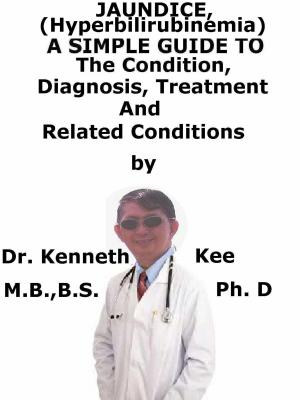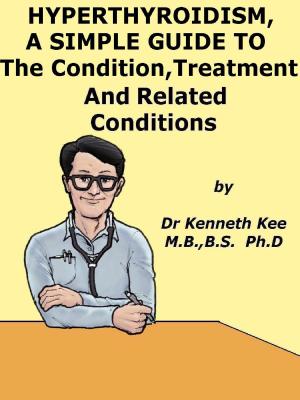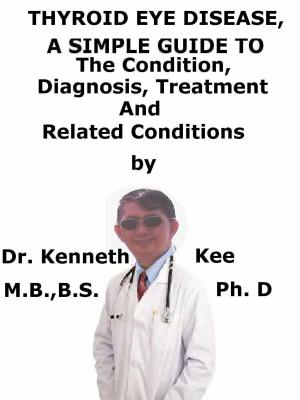HyperUricemia (Gout), A Simple Guide To The Condition, Diagnosis, Treatment And Related Conditions
Nonfiction, Health & Well Being, Medical, Specialties, Internal Medicine, Endocrinology & Metabolism, Orthopedics| Author: | Kenneth Kee | ISBN: | 9781370201358 |
| Publisher: | Kenneth Kee | Publication: | November 9, 2016 |
| Imprint: | Smashwords Edition | Language: | English |
| Author: | Kenneth Kee |
| ISBN: | 9781370201358 |
| Publisher: | Kenneth Kee |
| Publication: | November 9, 2016 |
| Imprint: | Smashwords Edition |
| Language: | English |
Hyperuricemia (Gout) is a medical disorder caused by the excessive uric acid in the blood.
Gouty arthritis is an arthritis which resulted from deposits of needle like crystals in the joint spaces.
The prickling effect of these needles induces sudden episodes of pain, tenderness, redness, warmth and swelling of the joints.
It is the most common form of arthritis in men over the age of 40.
Women are normally protected from gout until after menopause.
Uric acid is normally harmless and is produced in the body.
Most uric acid is passed out with the urine and some from the intestines with the feces (stools).
In people with gout the amount of uric acid in the blood goes up.
From time to time the level may become too high and tiny grit-like crystals of uric acid may form.
The crystals prick the tissues in the joint to cause inflammation, swelling and pain - a gout attack.
Acute gout is a painful condition that often affects only one joint.
Chronic gout is the repeated episodes of inflammation and pain.
More than one joint may be involved
Deposits can also form in the kidney and urinary tract as urate stones or crystals.
Urate crystals (tophi) are also deposited in the skin, mostly frequently at the joints and earlobe.
Gout is usually diagnosed if the patient has the typical gout symptoms and a raised blood level of uric acid.
Not everyone with high uric acid levels in the blood has gout.
Blood uric acid is raised above 7 mg/dL (high).
Typical features of gouty arthritis with warm red swollen and painful joint especially in locations such the big toe, ankle or knee
a. Synovial fluid analysis (shows uric acid crystals)
If there is doubt as to the source of the pain and swelling, the doctor may aspirate some fluid out of a swollen joint.
Crystals of uric acid (urate) can be seen in the fluid to confirm the diagnosis of gout.
Treatment of the acute gouty arthritis is:
1. Rest the joint
2. Drinks lots of water (e.g. 3 glasses of water) immediately during an acute attack.
3. If the patient is able to, raise the affected limb (normally a leg) to help decrease the swelling.
The easiest way to raise the leg is to recline on a sofa with the leg up on a cushion.
If the big toe is affected, raise it above the heart level to help the blood flow.
4. An ice pack placed against the inflamed joint may reduce the pain until the gout treatment medicines (below) start to act:
The guidelines advise colchicines and NSAIDs as the first-line option for acute gout.
NSAIDs are the first-line treatment
Colchicine helps reduce pain, swelling, and inflammation.
Probenecid lowers the uric acid through gradual excretion of uric acid in the urine.
Canakinumab is a recombinant monoclonal antibody active as a restrictor of pro-inflammatory cytokine IL-1 if colchicines and NSAIDs do not work.
Steroid tablets or injections can also decrease the inflammation and pain.
The central role recently identified for pro-inflammatory cytokine IL-1 has led to the production of inhibitors such as anakinra, canakinumab and rilonacept.
It is very important to drink at least 8 glasses of water daily to help flush out the uric acid.
Prevention can be with the use of Allopurinolol, probenecid and Febuxostat.
TABLE OF CONTENT
Introduction
Chapter 1 Hyper Uricemia
Chapter 2 Causes
Chapter 3 Symptoms
Chapter 4 Diagnosis
Chapter 5 Treatment
Chapter 6 Prognosis
Chapter 7 Osteoarthritis
Chapter 8 Rheumatoid Arthritis
Epilogue
Hyperuricemia (Gout) is a medical disorder caused by the excessive uric acid in the blood.
Gouty arthritis is an arthritis which resulted from deposits of needle like crystals in the joint spaces.
The prickling effect of these needles induces sudden episodes of pain, tenderness, redness, warmth and swelling of the joints.
It is the most common form of arthritis in men over the age of 40.
Women are normally protected from gout until after menopause.
Uric acid is normally harmless and is produced in the body.
Most uric acid is passed out with the urine and some from the intestines with the feces (stools).
In people with gout the amount of uric acid in the blood goes up.
From time to time the level may become too high and tiny grit-like crystals of uric acid may form.
The crystals prick the tissues in the joint to cause inflammation, swelling and pain - a gout attack.
Acute gout is a painful condition that often affects only one joint.
Chronic gout is the repeated episodes of inflammation and pain.
More than one joint may be involved
Deposits can also form in the kidney and urinary tract as urate stones or crystals.
Urate crystals (tophi) are also deposited in the skin, mostly frequently at the joints and earlobe.
Gout is usually diagnosed if the patient has the typical gout symptoms and a raised blood level of uric acid.
Not everyone with high uric acid levels in the blood has gout.
Blood uric acid is raised above 7 mg/dL (high).
Typical features of gouty arthritis with warm red swollen and painful joint especially in locations such the big toe, ankle or knee
a. Synovial fluid analysis (shows uric acid crystals)
If there is doubt as to the source of the pain and swelling, the doctor may aspirate some fluid out of a swollen joint.
Crystals of uric acid (urate) can be seen in the fluid to confirm the diagnosis of gout.
Treatment of the acute gouty arthritis is:
1. Rest the joint
2. Drinks lots of water (e.g. 3 glasses of water) immediately during an acute attack.
3. If the patient is able to, raise the affected limb (normally a leg) to help decrease the swelling.
The easiest way to raise the leg is to recline on a sofa with the leg up on a cushion.
If the big toe is affected, raise it above the heart level to help the blood flow.
4. An ice pack placed against the inflamed joint may reduce the pain until the gout treatment medicines (below) start to act:
The guidelines advise colchicines and NSAIDs as the first-line option for acute gout.
NSAIDs are the first-line treatment
Colchicine helps reduce pain, swelling, and inflammation.
Probenecid lowers the uric acid through gradual excretion of uric acid in the urine.
Canakinumab is a recombinant monoclonal antibody active as a restrictor of pro-inflammatory cytokine IL-1 if colchicines and NSAIDs do not work.
Steroid tablets or injections can also decrease the inflammation and pain.
The central role recently identified for pro-inflammatory cytokine IL-1 has led to the production of inhibitors such as anakinra, canakinumab and rilonacept.
It is very important to drink at least 8 glasses of water daily to help flush out the uric acid.
Prevention can be with the use of Allopurinolol, probenecid and Febuxostat.
TABLE OF CONTENT
Introduction
Chapter 1 Hyper Uricemia
Chapter 2 Causes
Chapter 3 Symptoms
Chapter 4 Diagnosis
Chapter 5 Treatment
Chapter 6 Prognosis
Chapter 7 Osteoarthritis
Chapter 8 Rheumatoid Arthritis
Epilogue















